Seville in 4 Days: everything you need to know
The colour, the sun, the art... It is clear that Seville has something that makes it special and in four days you have time to discover it.
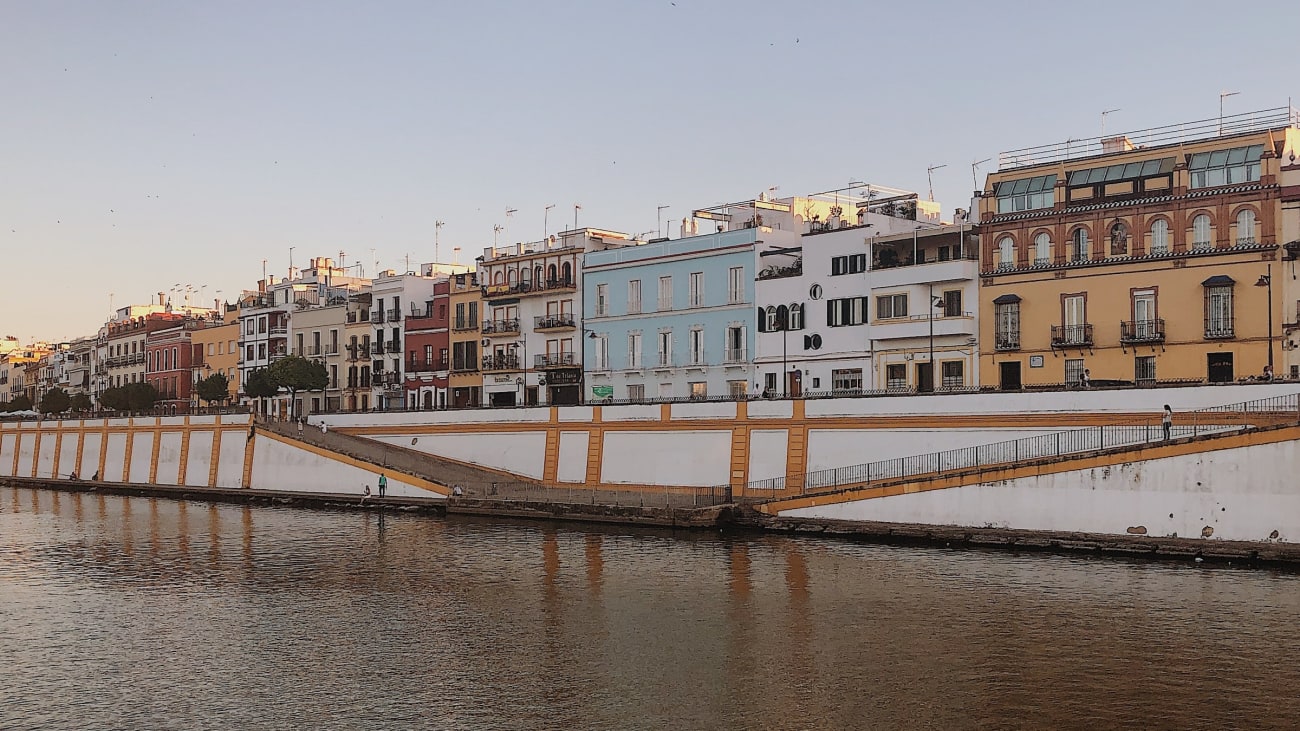
Seville | ©Isabella Smith
Are you planning your next trip? There are many things to see and do in Seville, so it's no wonder you've chosen this city as your destination. Its architecture, a blend of Moorish and Christian cultures, is the city's main attraction. However, there is much more to visit, such as its squares and gardens.
Before setting off for the capital of Andalusia, I would like to make a few travel suggestions. In four days you have more than enough time to see important places such as the Cathedral, the Giralda, the Alcázar and the Cartuja, but the key is to organise your itinerary well. Can I give you some tips?
Day 1: A tour of Seville's landmarks
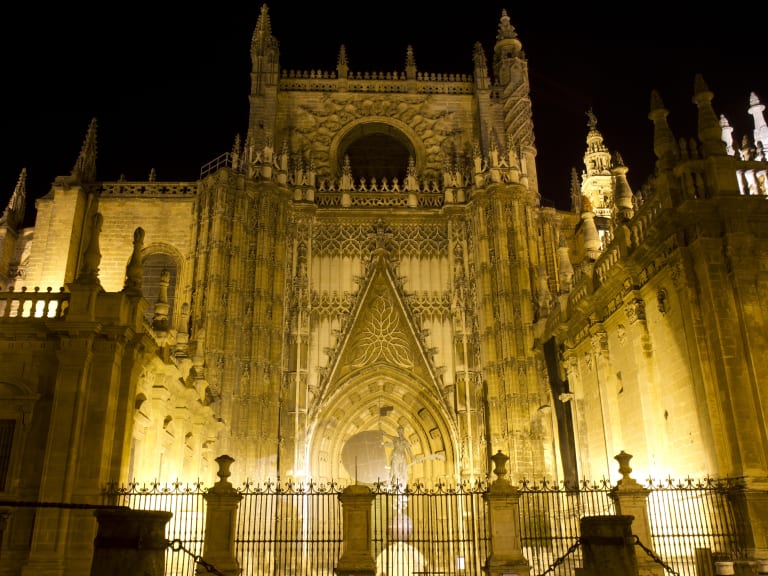
There is no better way to start your trip than visiting the Cathedral, the Giralda and the Alcazar of Seville on the first day. Three places that are symbols of the city and that are undoubtedly its best letter of introduction. Shall we start?
Start the day with a visit to Seville Cathedral
Seville Cathedral is the largest Gothic cathedral in the world. Did you know that? As soon as you walk through its door you will be able to see for yourself, as its architecture, decoration and sobriety are proof of this.
Although admiring it from the outside may seem enough, my advice is to go inside to take a tour of its chapels and contemplate how the light passes, full of colour, through its stained-glass windows. The price is approximately 12€.
Some of the rooms in the Cathedral that are worth a visit are the Patio de los Naranjos, a legacy of the Almohad mosque and with a lot of symbolism belonging to this culture, and the Biblioteca Colombina, which contains some documents written by Christopher Columbus.
Of course, another must-see is the Giralda, your next destination.
Climb the Giralda and contemplate Seville from above
Never has a bell tower achieved so much fame, but the Giralda is no less famous. Almost 100 metres high, this tower is the result of Seville's multicultural history.
The entrance fee to the Cathedral (approximately 12€) includes the climb to the Giralda, from where you will have spectacular views of the city.
For centuries two cultures have coexisted in Seville: Muslim and Christian. The Giralda is an architectural work that reflects this fact; the lower part of the tower is of Muslim origin and corresponds to the old minaret of the Almohad mosque, while the upper part was built as a bell tower for the Christian cathedral.
Stop for lunch in the Santa Cruz quarter
After climbing the Giralda you are probably a bit peckish, so before continuing your day I recommend you stop for lunch and see the Santa Cruz quarter of Seville.
This area was once home to the Jewish population. Although its narrow streets were not always famous, nowadays they are full of taverns and tapas bars.
The old Jewish quarter is now one of the favourite places for locals and tourists alike to go out for a bite to eat, especially if you want to try typical Andalusian dishes, such as montaditos (small sandwiches) or delicious squid. These are very traditional places, where they still write down the menu (and the bill) on chalk boards.
Discover the palaces of the Alcázar of Seville
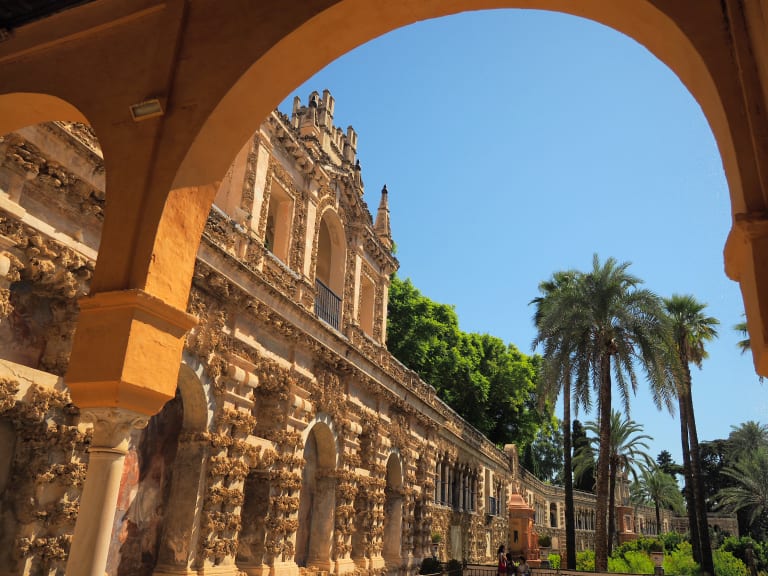
At the Real Alcázar of Se ville, multiculturalism makes a comeback; this place was originally a palace complex for the Arab caliphs, but over the centuries it was extended.
The whole complex is accessible for around 13€, although I recommend booking a guided tour of the Alcázar of Seville (around 35€) to see everything in more detail.
The Alcázar began to be built in the 10th century, although over the years it has been completed and more palaces have been built. To walk through each of them is to take a journey through history, from the Almoravid period to the Gothic period.
One of the most famous palaces for its ornamentation and rooms is the Mudejar Palace, where you can visit the famous Ambassadors' Hall or the Royal Alcove.
Discover history in the Archivo de Indias (Archive of the Indies)
As its name suggests, the Archivo de Indias contains thousands and thousands of folders and documents related to the administration of the Spanish colonies in America. It was built in 1785 for this purpose, as ordered by Charles III. The best thing about it? Admission is free and the visit won't take you too long. What's more, it's just a 1-minute walk from the Alcázar.
Maps, pages, data... The historical value of the corridors of the Archive of the Indies is incalculable, especially if we take into account that it contains the Capitulations of Santa Fe, the agreement signed by Christopher Columbus and the Catholic Monarchs.
Enjoy the emotion and art of a flamenco tablao
To round off the first day, how about going to a flamenco show in Seville? Entering a Sevillian tablao is one of those experiences you can't miss; these places are part of the city's culture, and you'll be treated to a show of music and dance that will leave you open-mouthed.
Flamenco is an art that is expressed through the heel tapping, the guitar, the singing... It's difficult to explain in words, but when you sit down to watch the show, you'll understand. A unique experience, in the centre of Seville, for around €20. There's no better way to end the day!
Day 2: A long walk to enjoy the good weather in Seville

For your second day I suggest a tour of the outdoors of Seville, a city full of patios, parks and gardens in which to enjoy the good weather all year round, including the Palacio de San Telmo, Plaza de España, María Luisa Park, the Torre del Oro and the Guadalquivir River.
Stroll through the courtyards of the San Telmo Palace
Nowadays it is the seat of the Junta de Andalucía, but originally the Palacio de San Telmo started out as a school for sailors' orphans.
It is located near the Alcázar, next to the University, and was also the residence of the Duke and Duchess of Montpensier. The best known feature of this palace is its façade, although you can also see the inside for free until 7 p.m. or so.
The exterior of the Palacio de San Telmo is impressive for its size and ornamentation. It was built in the baroque-churrigueresque style and has twelve statues of twelve illustrious Sevillians, such as the painter Diego Velázquez. Inside, if you decide to go inside, I recommend you take a stroll around the courtyards and be impressed by the decoration of the chapel.
Approach the Plaza de España and feel how it welcomes you
As soon as you leave the Palacio de San Telmo, a 10-minute walk will take you to the Plaza de España, your next stop. It was designed for the Ibero-American Exposition of 1929 and covers some 50,000 square metres. From one side of the square to the other runs a large bench representing the history of the provinces of Spain, giving a symbolic embrace and a warm welcome to its visitors.
Another striking feature is the canal, where boats can be hired for an hour or two for a nice ride. This place certainly looks like something out of the movies; in fact, it has been the setting for films such as Star Wars: Attack of the Clones.
Picnic in Maria Luisa Park
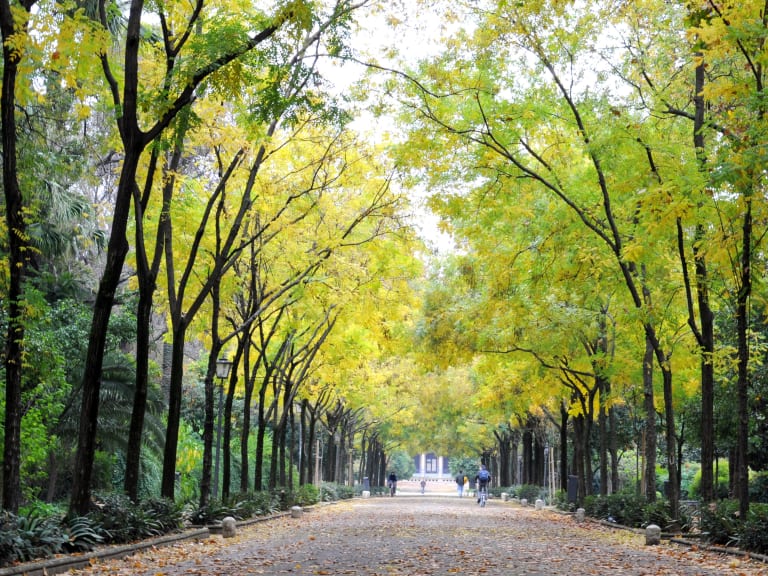
After sitting for a while on the benches in Plaza de España, it's time to leave it behind and enter María Luisa Park, Seville's green lung.
This large garden was originally part of the Palacio de San Telmo, but nowadays it's free to enter and a good place to bring some food and have a picnic.
When you've finished eating, you can wander around the grounds. Be warned, it's quite big, although you can always hire bikes or pedal cars to go faster and see more of the park. In any case, the best things to see in María Luisa Park are the ponds, full of water birds, and the artificial and decorative Mount Gurugú.
Look out over the Guadalquivir from the Torre del Oro (Gold Tower)
Why not take a walk away from the centre and go out to the banks of the Guadalquivir? Let your steps take you to the Torre del Oro in particular, where I recommend you climb to contemplate Seville from the top. Perhaps one of the great symbols of the city, this tower is more than 30 metres high and owes its name to the fact that its tiles apparently created glints of gold. To go up, you will have to pay the entrance fee (approximately €3) and climb a good flight of steps.
Like the Giralda, the Torre del Oro is also the result of different architectural styles. Its lower part is of Almohad construction, while the two upper parts are Christian, although built centuries apart.
End the day with a stroll along the Guadalquivir River
By the time you leave the Torre del Oro the day will be coming to an end, and there is no better way to watch the sun go down than by taking a stroll along the lower Guadalquivir. It's a beautiful area and, although walking is a great idea, it's even better to book a boat trip in Seville from the pier at the Torre del Oro. The itinerary is quite complete and affordable (approximately €20) and is accompanied by a commentary guide.
Touring Seville from the waters of the Guadalquivir is a nice souvenir to take away from your trip. On this tour you will have the opportunity to see not only the city, but also its river in a different way. You'll pass under its most famous bridges (such as the Triana Bridge) and see historic buildings such as the Castle of San Jorge, all while night falls over Seville.
You can also have fun paddle surfing on the river. This new type of tour is attracting more and more participants as it is a very entertaining way to surf standing up on a board on the Guadalquivir. All while enjoying unique views of the Triana Bridge and the Torre del Oro in the background.
Day 3: The best of Seville's gastronomy and tradition

Although the trip is coming to an end, there is still a lot to see, especially those places that are part of Seville's most authentic culture and tradition, such as the Maestranza or the Triana neighbourhood.
Have a sweet breakfast in Plaza del Cabildo square
It may not be the biggest square in the city, but the Plaza del Cabildo, located right in the centre, in front of the Cathedral, leaves no one indifferent, so there is no better place to start your third day in Seville. What stands out most is the arcade of what used to be the main façade of the Colegio de San Miguel, which was demolished in the 20th century.
If you haven't had breakfast yet, I recommend you buy some sweets in one of the shops in the square, where they sell products made in Seville's convents.
As well as confectionery, in the shops between the marble columns of the Plaza del Cabildo you can find antiques, especially in its Sunday stamp and coin market. In any case, I recommend taking a stroll around to contemplate the frescoes that decorate every arch in the square.
Visit the Church of the Hospital de la Caridad
Just a few minutes from the Plaza del Cabildo is the Church of the Hospital de la Caridad. If you've ever been interested in the Golden Age, you have to go in (the price is about 10 €) and, if not, you should too, as there is one of the most beautiful and best preserved altarpieces in the city.
Both the altarpiece and the rest of the church were painstakingly worked on symbolism and iconography, so be prepared to discover stories and biblical allusions in every corner, some of them made by painters like Zurbarán or Murillo.
Get to know the El Arenal neighbourhood
While you are at the Hospital de la Caridad, I encourage you to take a stroll through the neighbourhood where it is located: El Arenal. It is one of the most cosmopolitan areas of Seville, but it also has an important past: it was the point where the ships that later sailed to the Indies arrived. When you walk through its streets, let yourself be infected by the energy of its people.
It could be said that Seville's El Arenal neighbourhood is famous for its bullfighting tradition, partly because it is home to the La Maestranza bullring, which I recommend you visit in the afternoon. It also has a strong religious devotion and its streets are home to many brotherhoods and brotherhoods.
Take a tapas tour of the centre of Seville
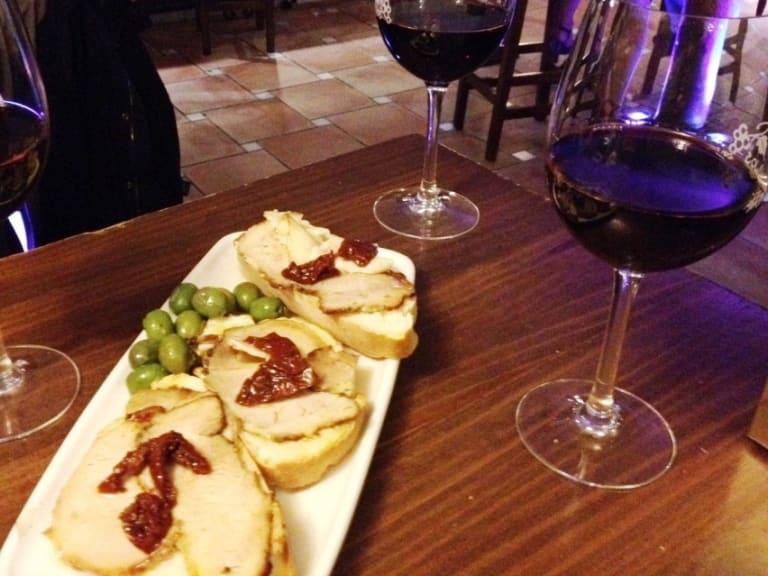
While you're in the city centre, why not take a tapas tour of Seville? Sometimes it can be difficult to find the best places, avoiding the most touristy and expensive ones, so it's a good idea to book a gastronomic tour. They cost around €80 and include good food and wine.
The best thing about these tours is that they take you to the most authentic restaurants and taverns, the ones that prepare real food. As you savour each tapa, a guide will explain Sevillian traditions and the city's gastronomic culture.
Discover the oldest bullring in Seville: La Maestranza
Even if you don't like or are not in favour of bullfighting, the Plaza de la Maestranza is an emblematic place in Seville, so I suggest you visit it at least from the outside. Its fame is due not only to the bullfighters who have walked in its arena, but also to the fact that it is one of the oldest bullrings in Spain.
To get there, all you have to do is walk from the centre towards the Guadalquivir, as the entrance is on Paseo de Cristóbal Colón.
It took more than 100 years to finish building it. Its façade was designed in a late Baroque style, so there are Classicist elements, and it is notable for the two towers at the entrance, which are topped with curved and highly ornamented forms.
Cross the Isabel II Bridge to go to the Triana quarter
Leaving the Maestranza, head towards the Guadalquivir to cross the Isabel II Bridge to the Triana quarter, the place where you will end the day. There is a lot to see and do in Triana, as it is one of the most special areas of Seville due to its cultural value, for having been the birthplace of singers and dancers and for its long history.
It was first settled by Roman troops in what is now known as the Triana neighbourhood. In any case, its inhabitants have always been linked to the seafaring tradition due to its proximity to the river, which is also a danger due to the flooding of the Guadalquivir.
My advice is to take a long walk through its streets and, when hunger strikes, sit down on a terrace for dinner or, even better, go to the best bars in the area with a professional guide to taste the most typical tapas and drinks of the Triana neighbourhood.
Day 4: Say goodbye to Seville with a tour of the Cartuja and the city centre

The trip is coming to an end, but before leaving I recommend you to visit some of the more modern, but not less important or historical places. La Cartuja is one of them, although you will also have the opportunity to say goodbye to Seville from the top.
Cross over to the Isla de la Cartuja
It is clearly not the oldest neighbourhood in Seville (it was built in preparation for the 1992 Expo), but the Isla de la Cartuja is a must-see. With its modern feel, it is a cultural and leisure centre where there is always something to do.
To get there, you'll have to walk a bit (it's about half an hour from the centre) or take the bus (lines C1 and C2 connect the centre with the Cartuja). Once there, you can move freely between the different buildings in this large park.
The main building is arguably the Cartuja Monastery (now the Andalusian Centre of Contemporary Art), although there are other places you can also visit, such as the Caixaforum (whose exhibitions and activities are perfect if you are travelling to Seville with children) or the Alamillo Park (the largest in the city).
Enter the Palacio de Las Dueñas and discover its artistic value
To return to the centre, cross the Pasarela de la Cartuja and enjoy a stroll through the streets of Seville until you reach the Palacio de Las Dueñas, your next destination.
This Gothic, Mudejar and Renaissance building belongs to the House of Alba, one of Seville's historic noble families. Although its exterior may already be striking, the great treasure lies inside, both for its gardens and for the art collections it houses. Declared an Asset of Cultural Interest in 1931 and renovated several times since its construction in the 15th century, it was the habitual residence of the Alba family.
Admission is approximately 12€ and it is worth the entrance fee to see the Mudejar arches in the courtyards and the tiled skirting boards. Of course, you'll also be able to see the works of art preserved inside.
Stop for a bite to eat at the Mercado de la Encarnacion
Starting to get hungry? You're in luck because just a few metres away (barely a 5-minute walk from the Palacio de Las Dueñas), you'll find the Mercado de la Encarnación, the oldest market in Seville, where you can buy fresh produce and typical dishes already cooked. The years may have passed, but the spirit of this place has not changed: friendly service and the best Sevillian cuisine.
You may be surprised to know that, despite being the oldest market in Seville, the Mercado de la Encarnación you are about to visit dates back to the beginning of the 21st century. Why? Because the original one had to be demolished in 1937 due to its poor structure, and it took a few years for the current one to be inaugurated.
When you have finished eating, take the opportunity to go up to the Setas de Sevilla, a viewpoint from which you can look out over the city.
Continue your tour of Seville with a visit to Plaza Nueva.
After lunch, take a 15-minute stroll towards Plaza Nueva, taking the opportunity to pass in front of the Collegiate Church of the Divine Saviour. The main attraction of Plaza Nueva, apart from being the centre of the city, is that it is home to Seville's Town Hall. This area has been renovated (and renamed) on several occasions, although it has always maintained its atmosphere.
As Seville's main square, many events are held here throughout the year, from Holy Week processions to demonstrations. In general, it is a place where there are always children playing and, when the day is over, there is a lot of nightlife.
End the day at the Royal Parish Church of Santa María Magdalena
To end your day and your trip, why not pay a visit to the Royal Parish Church of Santa María Magdalena? It may not be one of the places that usually appears in the guidebooks, but I recommend you go inside ( access is free during opening hours) to appreciate its neat decoration full of plasterwork, bricks and tiles.
The current parish was built on the remains of a mosque and was demolished on a couple of occasions to open up the square. It is known not only for its architecture and baroque interior, but also for having been the first seat of the Inquisition.
The tourist bus: a good way to get around Seville

Although it is generally possible to walk from one place to another, it is possible that the high temperatures in Seville make it difficult to get around, especially in the middle of the day.
One option for getting around the city during peak heat is to take a tourist bus around Seville, which has stops at the most important places, is air-conditioned and is not as crowded as the metro or public bus.
As well as the convenience of having an air-conditioned means of transport to get from one place to another without getting hot or wasting time between intermediate stops that don't interest you, the best thing about these tourist buses is that they have a guide so that, before you arrive, you already know what is most important in each place.
A summary of your 4-day tour of Seville
- Day 1
- Visit the Cathedral of Seville
- Climb to the top of the Giralda
- Have a bite to eat in the Santa Cruz quarter
- Discover the Alcazar
- Discover the Archivo de Indias
- Attend a flamenco show
- Day 2
- Visit the Palace of San Telmo
- Visit the Plaza de España
- Have a picnic in Maria Luisa Park
- See Seville from the Torre del Oro (Golden Tower)
- Take a stroll along the banks of the Guadalquivir River
- Day 3
- Have a sweet breakfast at the Plaza del Cabildo
- Visit the Church of the Hospital de la Caridad
- Get to know the Arenal neighbourhood
- Take a tapas tour through the centre of Seville
- Go to the Maestranza bullring
- Stroll through the Triana neighbourhood
- Day 4
- Visit the Isla de la Cartuja
- Visit the Palace of Las Dueñas
- Have lunch at the Encarnación Market
- Visit the Plaza Nueva of Seville
- Enter the Royal Parish Church of Santa María Magdalena
Are you missing something to organise? I hope my tips and suggestions will help you enjoy Seville, and you'll let me know when you get back!
